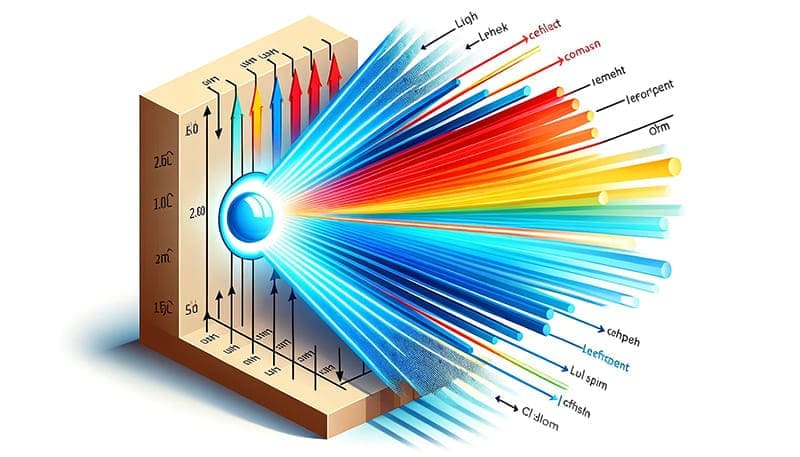Imagine a world where we can manipulate light to unveil the mysteries of the universe, from the composition of a simple solution to the vastness of space. This is not just a realm of science fiction; it’s the reality of scientific exploration, thanks to a fundamental concept known as the Refractive Index (RI). In the intricate world of laboratory glassware, RI is not just a number; it’s the key to unlocking new frontiers in research and technology. Join us on a journey to discover how this unseen force shapes the tools of scientific discovery and drives innovation in countless fields.
Refractive Index (RI) is that unseen science, a pivotal concept in laboratory glassware. It is the measure of how much light bends, or refracts, when entering a material from another medium, like air into glass. This bending of light is not just a curious optical phenomenon; it’s a crucial factor in scientific experiments and technological applications.
Understanding refractive index is not just interesting, it’s essential for the progress of science. Stay with us as we explore this fascinating concept.

What is Refractive Index?
Refractive Index, symbolized as ‘n’, is a dimensionless number that describes how light, or any other radiation, propagates through a medium. It’s the ratio of the speed of light in a vacuum to its speed in a specific substance. For example, the refractive index of water is approximately 1.333, which means light travels 1.333 times slower in water than in a vacuum.
This property is not just a number; it’s a gateway to understanding how light interacts with materials, which is critical in fields like optics and chemistry.
Why is Refractive Index Important in Laboratory Glassware?
In a laboratory setting, glassware is not just a container; it’s an integral part of the experiment. The refractive index of glass determines how it will interact with light, which is vital in experiments involving spectroscopy, light microscopy, and laser technology.
Different types of glass have different refractive indices, tailored to specific experimental needs. For instance, borosilicate glass, commonly used in lab glassware, has a different refractive index than ordinary glass, making it more suitable for certain types of optical work.
Understanding the refractive index of the glassware used can lead to more accurate and reliable experimental results.

Applications of Refractive Index in Laboratories
The refractive index finds numerous applications in a laboratory setting:
- Concentration and Purity Analysis: In chemistry, RI is used to determine the concentration and purity of solutions. By measuring how light refracts through a solution, scientists can deduce the concentration of solutes in it.
- Optical Instrument Calibration: Instruments like microscopes and spectrophotometers rely on precise optical components. Knowing the refractive index of these components allows for better calibration and, consequently, more accurate measurements.
- Studying Reaction Kinetics: In chemical reactions, changes in concentration can be monitored using RI, providing insights into the reaction kinetics.

Practical Applications of Refractive Index in Laboratories
The application of refractive index in laboratories has led to significant achievements and advancements in various scientific fields.
Enhancing Optical Measurements
One of the most direct applications of refractive index in laboratories is in enhancing optical measurements. Glassware with a known refractive index is crucial in experiments involving light, such as spectrometry and microscopy. Accurate knowledge of the refractive index allows scientists to correct for any distortions or aberrations caused by the glass, leading to more precise measurements.
Improving Chemical Analysis
In the field of chemical analysis, the refractive index is used to determine the purity and concentration of substances. For instance, in pharmaceuticals, the refractive index of a solution can indicate the concentration of an active ingredient, which is vital for quality control and dosage determination.
Advancing Material Science
The study of materials, particularly in developing new compounds and substances, often requires precise measurement of refractive index. This helps in understanding the optical properties of materials, which is crucial in industries like semiconductor manufacturing and nanotechnology.
Facilitating Breakthroughs in Biomedical Research
In biomedical research, the use of glassware with specific refractive indices has contributed to advancements in imaging techniques, such as high-resolution microscopy. This has allowed for more detailed observations at the cellular and molecular level, leading to breakthroughs in understanding diseases and developing new treatments.

Contributions to Scientific Development
The application of refractive index in laboratory settings has significantly contributed to various scientific advancements.
Promoting Accuracy in Experiments
By using glassware with a known refractive index, scientists can ensure the accuracy of their experiments. This precision is crucial in research fields where even the slightest error can lead to vastly different outcomes.
Driving Technological Innovations
The understanding of refractive index has been instrumental in driving technological innovations. In fields such as telecommunications, the development of fiber optics based on principles of refraction has revolutionized the way we communicate.
Supporting Environmental Research
In environmental research, the use of refractive index measurements has helped in the analysis of air and water quality. This has been crucial in monitoring pollution levels and understanding environmental changes.
Enhancing Educational Practices
In education, teaching the concept of refractive index and its applications in laboratories helps in nurturing a new generation of scientists. Practical experiments involving the refractive index deepen students’ understanding of optical phenomena and their real-world applications.

Expanded Challenges and Considerations in Using Refractive Index
The use of refractive index (RI) as a tool in scientific measurements, while powerful, presents several challenges and considerations that require careful attention.
Temperature Sensitivity and Its Impact
The refractive index of a material can vary with temperature changes. This sensitivity poses a significant challenge, especially in experiments where precision is paramount.
The Problem
As temperature increases, the density of a material can decrease, leading to a change in its refractive index. In laboratory settings, even minor fluctuations in temperature can cause significant variations in RI measurements, potentially leading to inaccurate results.
Strategies for Mitigation
- Controlled Environment: Conducting experiments in a temperature-controlled environment is essential. Using thermostatically controlled laboratory spaces can minimize temperature fluctuations.
- Calibration with Temperature: Instruments used for measuring RI should be calibrated with respect to temperature. This includes using temperature compensation in refractometers or incorporating temperature sensors.
- Use of Temperature-Insensitive Materials: Whenever possible, using materials with low thermal expansion coefficients can reduce the impact of temperature on RI.
Material Specificity and Selection Challenges
Different materials exhibit different refractive indices, which can be a challenge when selecting the appropriate glassware for specific experiments.
The Issue
The refractive index is not a universal constant but varies from one material to another. This variation means that the light-bending properties of each material are unique. In a laboratory setting, using the wrong type of glassware can lead to incorrect bending of light, affecting experimental outcomes.
Approaches for Addressing This Challenge
- Material Research and Selection: Understanding the properties of different types of glassware and selecting the right type based on its refractive index is crucial. For instance, borosilicate glass, known for its low coefficient of thermal expansion and relatively consistent refractive index, might be preferred for high-temperature experiments.
- Custom Fabrication: In some cases, custom fabrication of glassware with specific refractive indices might be necessary, especially for highly specialized research.
- Regular Testing and Verification: Regularly testing the refractive index of glassware to ensure it remains consistent and within the required specifications for the intended experiments.
Additional Considerations in Using RI
- Instrument Precision: The precision of instruments used to measure refractive index must be high. Regular calibration and maintenance of these instruments are crucial.
- Interference Effects: In some experimental setups, interference effects due to multiple reflections within the glassware can alter the path of light, affecting the refractive index measurement. Using anti-reflective coatings or designing experiments to minimize these effects can be helpful.
- Sample Preparation: The way a sample is prepared, including its purity and homogeneity, can affect its refractive index. Rigorous sample preparation protocols are necessary for accurate RI measurements.

The Intersection of Refractive Index and Emerging Technologies
As technology evolves, the interplay between refractive index and emerging scientific fields is becoming increasingly prominent, particularly in laboratory glassware.
Nanotechnology and Glassware
In the burgeoning field of nanotechnology, the refractive index is pivotal in designing nanoscale glassware. Such glassware can be used for highly sensitive experiments, where the interaction of light with materials at the nanoscale is critical.
Advanced Imaging Techniques
The development of advanced imaging techniques in microscopy is also reliant on the refractive index. High-precision glass lenses with specific refractive indices are essential for creating clearer, more accurate images, particularly in biomedical research.
Photonic Computing
Photonic computing, which uses photons in place of electrons for computation, is an area where the refractive index of glassware plays a crucial role. Laboratory glassware in this field needs to have precise refractive properties to manipulate light effectively for computational purposes.

The Refractive Index in Chemical Synthesis and Analysis
In chemical synthesis and analysis, the role of the refractive index continues to expand.
Catalysis Research
For research in catalysis, glassware with specific refractive properties can enhance the effectiveness of catalysts by affecting how light interacts with the materials, potentially leading to more efficient chemical reactions.
Spectroscopic Analysis
In spectroscopic analysis, the refractive index of glassware can affect the accuracy of measurements. Glassware that minimizes unwanted refraction or reflection can lead to more precise data, critical in fields like pharmaceuticals and environmental testing.
Refractive Index in Space Exploration and Astronomy
The exploration of space and the study of astronomy also benefit from glassware with specific refractive properties.
Telescope Lenses
Telescope lenses, made from glass with precise refractive indices, are essential for observing distant celestial objects. The quality of these lenses directly impacts the clarity and accuracy of astronomical observations.
Spacecraft Instruments
Instruments aboard spacecraft, designed for exploring other planets and moons, often include glass components. The refractive index of these components is crucial for ensuring the accuracy of measurements taken in space.

The Future of Refractive Index in Laboratory Glassware
Looking ahead, the refractive index is set to play an even more integral role in the evolution of laboratory glassware.
Smart Glassware
The development of ‘smart glassware’, which could change its refractive properties in response to different stimuli, is a potential area of innovation. This could allow for more versatile and adaptive laboratory equipment.
Sustainable Manufacturing
Efforts towards sustainable manufacturing practices in glassware production could also be informed by refractive index studies. This would involve creating glassware that not only meets scientific needs but also minimizes environmental impact.
Global Collaboration
As scientific challenges become more complex, global collaboration in refining glassware technology through the understanding of refractive index will be essential. Sharing knowledge and innovations can accelerate advancements in various scientific fields.

The Educational Importance of Refractive Index
In educational settings, teaching the concept of refractive index is vital. It not only introduces students to fundamental optical principles but also encourages critical thinking and experimental skills.
Curriculum Integration
In physics and chemistry classes, refractive index experiments are an excellent way to demonstrate the properties of light and materials. Simple experiments, such as bending light using water or lenses, can be fascinating and insightful for students, sparking their interest in science.
Laboratory Skills Development
Understanding and measuring the refractive index in a laboratory setting is a practical skill for budding scientists. It teaches them about precision in measurement and the importance of variables like temperature and material composition.
Foundation for Advanced Studies
For students pursuing higher education in physics, chemistry, or engineering, a solid understanding of refractive index is essential. It forms the basis for more complex studies in optics, materials science, and various engineering disciplines.

Global Significance of Refractive Index
The concept of refractive index goes beyond laboratories and classrooms; it has a global significance.
Telecommunications
In the global telecommunications industry, the application of refractive index in the design of optical fibers and cables has been a game-changer. It has enabled faster, more reliable internet and communication networks around the world.
Climate Change Research
In climate change research, understanding the refractive properties of atmospheric particles helps in modeling and predicting climate patterns. This knowledge is crucial for developing strategies to combat climate change and protect the environment.
International Standards and Trade
Refractive index measurements are also important in international trade, especially for products like glass, gemstones, and various liquids. Standardized measurements ensure quality and consistency in global markets.

Future Directions and Innovations
As technology advances, the applications of refractive index are set to expand even further.
Metamaterials
The development of metamaterials, with their unique refractive properties, opens up possibilities for creating ‘invisible’ materials and ultra-powerful lenses.
Biotechnology
In biotechnology, the use of refractive index measurements can lead to breakthroughs in imaging and diagnostics, improving our understanding of biological processes and diseases.
Sustainable Energy
The application of materials with specific refractive indices can improve the efficiency of solar energy devices, contributing to the development of sustainable energy solutions.
Conclusion
In conclusion, the Refractive Index is more than just a scientific term; it’s the backbone of innovation and precision in laboratories worldwide. It empowers scientists to explore, create, and transform our understanding of the natural world. As we continue to delve into the mysteries of light and materials, let’s embrace the power of refractive index, inspiring a future where scientific boundaries are continually pushed, and new horizons of knowledge are explored. The journey of discovery is endless, and it starts with understanding the fundamental concepts that shape our world.










